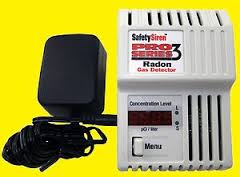
What is radon?
Radon is a radioactive gas. it is colorless, odorless, tasteless, and chemically inert. Unless you test for it, there is no way of telling how much is present.
Radon is formed by the natural radioactive decay of uranium in rock, soil, and water. Naturally existing, low levels of uranium occur widely in Earth's crust. It can be found in all 50 states. Once produced, radon moves through the ground to the air above. Some remains below the surface and dissolves in water that collects and flows under the ground's surface.
Radon is measured in picocuries per liter of air (pCi/L), a measurement of radioactivity. In the United States, the average indoor radon level is about 1.3 pCi/L. The average outdoor level is about 0.4 pCi/L. The U.S. Surgeon General recommend fixing homes with radon levels at or above 4 pCi/L.
Health Effects
Breathing radon can increase your risk of lung cancer. The Surgeon General has warned that radon is the second leading cause of lung cancer in the United States. Only smoking causes more cases of lung cancer. If you smoke and are exposed to elevated radon levels, your risk of lung cancer is even higher.
Radon gas decays into radioactive particles that can get trapped in our lungs when you breathe. As they break down further, these particles release small bursts of energy, which can damage lung tissue and lead to lung cancer over the course of a lifetime. Not everyone exposed to elevated levels of radon will develop lung cancer and the amount of time between exposure and the onset of the disease may be many years.
How does radon get into a building?

Most indoor radon comes into the building from the soil or rock beneath it. Radon and other gases rise through the soil and get trapped under the building. The trapped gases build up pressure. Air pressure inside homes is usually lower than the pressure in the soil. Therefore, the higher pressure under the building forces gases through floors and walls and into the building. Most of the gas moves through cracks and other openings. Once inside, the radon can become trapped and concentrated.
Radon may also be dissolved in water, particularly well water. After coming from a faucet, about one ten thousandth of the radon in water is typically released into the air. The more radon there is in the water, the more it can contribute to the indoor radon level.
Should you test for radon?
Nearly one out of every 15 homes has a radon level the EPA considers to be elevated (4 pCi/L or greater). The U.S. average radon-in-air level in a single family home is 1.3 pCi/L. Because most people spend as much as 90% of their time indoors, indoor exposure to radon is an important concern.
While radon problems maybe more common in some geographic areas, any home may have an elevated radon level. New and old homes, well-sealed and drafty homes, and homes with or without basements can have a problem. The only way to determine the level of radon in your home is to have it tested.
Testing is easy!

A simple test will tell you if your home has a high radon level. Most radon test last between 2 and 7 days. It is easy as opening a package, and putting the test kit in the right place. After sending the test kit back to the address in the package, the company will send your radon test results in about 2 weeks.
Radon test can be found at many local home improvement or hardware stores. Test kits can be ordered online too. You can also hire a qualified tester to do a radon test for you, the Kansas Radon Program may keep a list of these professionals.
Cost?
Many kits are priced under $25.00 at your local home improvement or hardware store. You can request a test kit from the Kansas Radon Program, available on a first come first serve basis. The cost to reduce radon depends on how your home was built and how you use it. Most homes can be fixed for about the same cost as other common home repairs.
Other Resources
- Basic Radon Facts (PDF)- U.S. Environmental Protection Agency
- Is Radon a Real Problem? (PDF) – Kansas Radon Program
*Sources: Kansas Radon Program, National Safety Council (NSC) and U.S. Environmental Protection Agency (EPA).*
